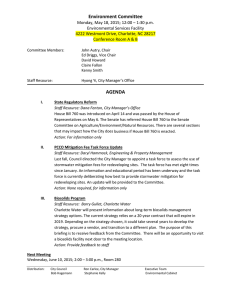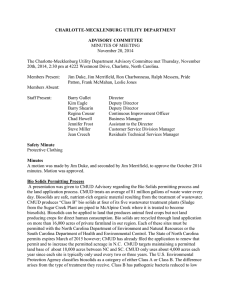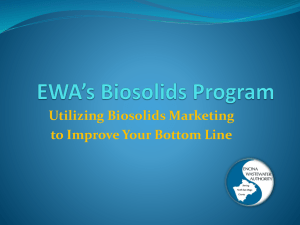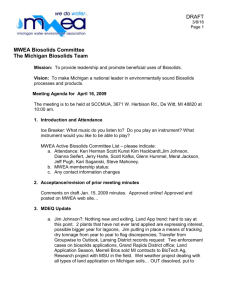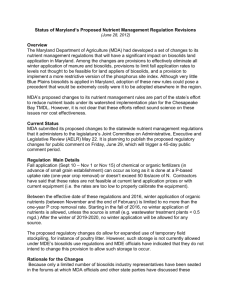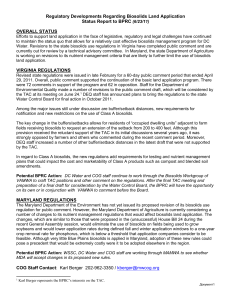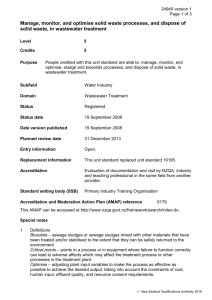Living in Bosnia-Herzegovina - McGraw Hill Higher Education
advertisement
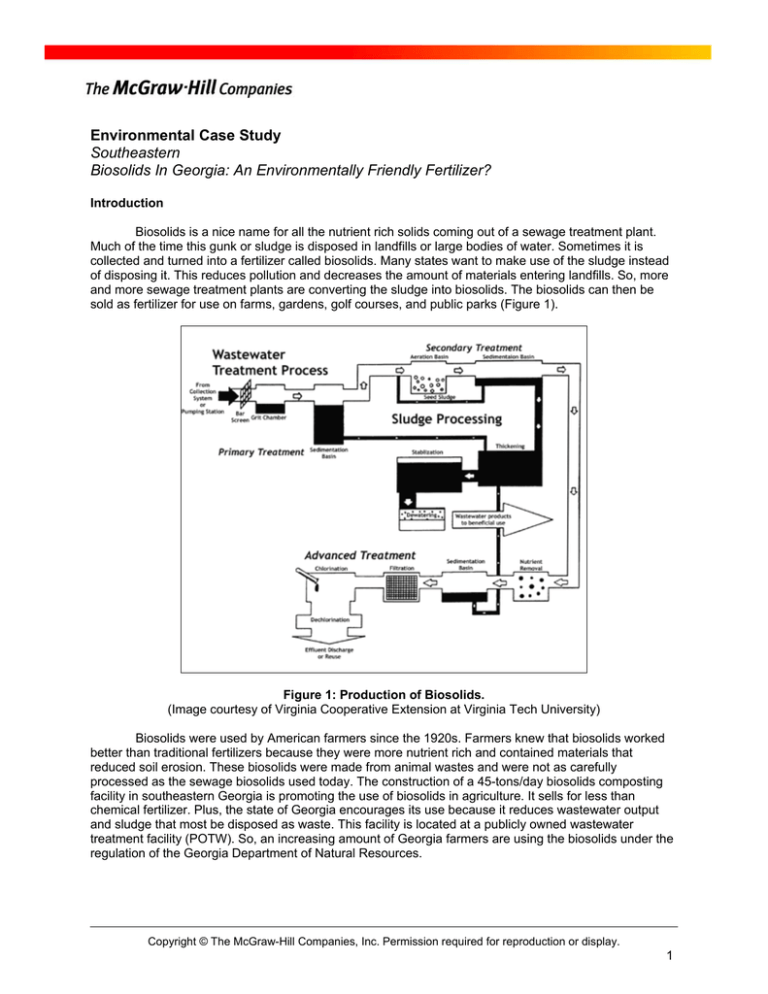
Environmental Case Study Southeastern Biosolids In Georgia: An Environmentally Friendly Fertilizer? Introduction Biosolids is a nice name for all the nutrient rich solids coming out of a sewage treatment plant. Much of the time this gunk or sludge is disposed in landfills or large bodies of water. Sometimes it is collected and turned into a fertilizer called biosolids. Many states want to make use of the sludge instead of disposing it. This reduces pollution and decreases the amount of materials entering landfills. So, more and more sewage treatment plants are converting the sludge into biosolids. The biosolids can then be sold as fertilizer for use on farms, gardens, golf courses, and public parks (Figure 1). Figure 1: Production of Biosolids. (Image courtesy of Virginia Cooperative Extension at Virginia Tech University) Biosolids were used by American farmers since the 1920s. Farmers knew that biosolids worked better than traditional fertilizers because they were more nutrient rich and contained materials that reduced soil erosion. These biosolids were made from animal wastes and were not as carefully processed as the sewage biosolids used today. The construction of a 45-tons/day biosolids composting facility in southeastern Georgia is promoting the use of biosolids in agriculture. It sells for less than chemical fertilizer. Plus, the state of Georgia encourages its use because it reduces wastewater output and sludge that most be disposed as waste. This facility is located at a publicly owned wastewater treatment facility (POTW). So, an increasing amount of Georgia farmers are using the biosolids under the regulation of the Georgia Department of Natural Resources. Copyright © The McGraw-Hill Companies, Inc. Permission required for reproduction or display. 1 Environmental Case Study Southeastern Biosolids In Georgia: An Environmentally Friendly Fertilizer? Background It is important to know how sewage treatments operate in order to understand the issues related to the use of biosolids as fertilizer. Sewage treatment plants collect wastewater from commercial and household bathtubs, sinks, and toilets. They may also collect water used in industrial processes and rainwater running into storm drains. This water mingles to produce a body of water polluted with a wide variety of materials. The first step of treating the pooled wastewater involves a screening process that removes large pieces of junk. The junk ranges from dental floss to plastic wrap to sticks. Systems that collect water from storm drains have many more pieces of junk to clean out of water entering the plant. This stuff is usually discarded. After this the screened water is placed into a large tank that settles out all of the rocks and soil. This “grit” is sometimes collected and used as landfill. Now the water must be treated to remove the organic materials including pathogenic microorganisms and many types of pollutants. Approximately 90% of the organic material is removed in what is called secondary water treatment. There are various ways of removing the organic material. Most common are aeration tanks that encourage the growth of bacteria which digest the organic material. These bacteria also inhibit the growth of pathogens. The oxygen used in the aeration process also destroys many pathogens and helps break down certain organic molecules. In the meantime, solid materials are allowed to settle with the help of certain chemicals. The solids then form the sludge that is converted into biosolids. Biosolids are heated and dried to form a powdery solid material that can be used in place of fertilizer (Figure 2). Figure 2: Fresh biosolids processed for fertilizer. (Photo courtesy of Texas A&M University) The Issues Biosolids used in place of chemical fertilizer can save farmers as much as $100 per acre in production costs. This is very important considering the ever increasing cost of running a farm. Biosolids Copyright © The McGraw-Hill Companies, Inc. Permission required for reproduction or display. 2 Environmental Case Study Southeastern Biosolids In Georgia: An Environmentally Friendly Fertilizer? used for agriculture is regulated by the Environmental Protection Agency (EPA) in a document called 40 CFR Part 503 which took effect in 1993. The EPA analyzed 411 of over thousands of pollutants found in sludge before deciding on its use in agriculture. They determined to regulate the safety levels of 9 hazardous metals that end up in biosolids. Most farmers feel that the bisolids are safe and the government has seen no ill effects on animals and people eating the crops. Recently there has been a legal case claiming harm done by the use of sewage biosolids in agricultural and application. On June 24, 2003, a Georgia court ruled that the biosolids were responsible for destroying the Boyce family farm’s dairy herd and damaging farm property. Boyceland Dairy in Georgia sued the city of Augusta because they believed toxic metals from the city’s sewage sludge poisoned cattle and land. There was no evidence that the sludge used on the Boyce farm was out of compliance with EPA’s 1993 rules sludge. Yet, verbal evidence indicated that the biosolids caused the environmental harm. Environmental groups are also filing suites against the government for biosolids use. They feel that the other pollutants in biosolids can cause significant environmental harm. These pollutants end up in the food and wash into water supplies near the farms and other establishments using the biosolids. Hazardous chemicals such as dioxins have been found in biosolids. These organic pollutants can build up in the environment as biosolids and are used. This, in effect, can lead to toxic amounts building up in the bodies of animals and plants. The environmental groups want to limit the use of existing biosolids or want to see tighter regulations on the types of materials tested when determining biosolids safety. References Literature 1. Environmental Protection Agency. 1994. Land Application of Sewage Sludge: A Guide for Land Appliers on the Requirements of the Federal Standards for the Use or Disposal of Sewage Sludge, 40 CFR Part 503. Washington, DC: Office of Enforcement and Compliance Assurance. 1. National Research Council. 2002. Biosolids applied to land: Advancing standards and practices. National Academy Press, Washington, DC. 2. Payne, M., Janiec, M., Marsh, M., Patterson, J., Stone, R. and Larry Schut. 2001. Land application of sewage biosolids for crop production. Environmental Science and Engineering, September. Web Sites 1. National Biosolids Partnership http://www.biosolids.org/ 2. United States Environmental Protection Agency http://www.epa.gov/owm/mtb/biosolids/ Key Principles 1. 2. 3. 4. Biosolids Recycling Sewage treatment Wastewater Copyright © The McGraw-Hill Companies, Inc. Permission required for reproduction or display. 3 Environmental Case Study Southeastern Biosolids In Georgia: An Environmentally Friendly Fertilizer? 5. Waste disposal Ethical Considerations 1. Should governments require the use of biosolids to reduce the production of wastes? 2. How should governments address the views of people having concerns about the safety of biosolids? 3. How does one weigh the benefits and risks of using biosolids for agricultural use? 4. What evidence should be used to determine any harm claimed by the use of biosolids? Civic Engagement & Service Opportunities 1. 2. 3. 4. Volunteer for a local community group involved in protecting the environment in your area. Write or e-mail your local politicians about biosolids use in your area. Form a student group having an environmental preservation mission. Set up a public forum at your school discussing any biosolids practices used in your area. Learn more about community service as part of your educational enrichment by visiting the following websites: http://www.learnandserve.org/, http://www.servicelearning.org/. Author Dr. Brian Shmaefsky Professor of Biology & Service Learning Coordinator Kingwood College 20,000 Kingwood Drive, HSB 202V Kingwood, TX 77339 Brian.shmaefsky@nhmccd.edu Copyright ©2007 The McGraw-Hill Companies. Any use is subject to the Terms of Use and Privacy Policy. McGraw-Hill Higher Education is one of the many fine businesses of The McGraw-Hill Companies. Copyright © The McGraw-Hill Companies, Inc. Permission required for reproduction or display. 4

